The outstanding queen of Hungary and Poland. The first woman in the history of our country who ruled the whole country on her own, without looking back at any man. The gray eminence of European politics. She was going to die as she lived:in full control of the situation.
Elżbieta Łokietkówna (1305-1380) remained active until the last moments of her long seventy-five-year life. Although she decided to withdraw from public life a few years before her death, she disappeared from public life for many months, but in 1378 the development of events brought her out of her lethargy again. It was then that the eldest daughter of her son died at the age of only eight - Katarzyna Andegaweńska, who was expected to be the future queen of Poland and Naples. Thus, the agreement concluded with the French broke up, and the future of the rule on the Vistula River was put into question.
Elizabeth was back in her element. The crisis gave her strength, and the need for a moment awakened in her almost incredible determination. In the summer of 1379, the 74-year-old queen once again summoned Polish delegates to Košice - just like five years ago, when the famous Košice privilege was issued.
This time she was not going to ask or persuade. As soon as the dignitaries of Greater Poland began to sulk and demand new concessions for the consent to the coronation of the second royal daughter, Elizabeth and her son, King Louis of Anjou ... ordered the city gates to be closed. And the same:to imprison the visitors until they repent. The effect has been achieved. Poles paid tribute to Princess Maria. Elżbieta, on the other hand, without waiting for anything, set off straight to Krakow.
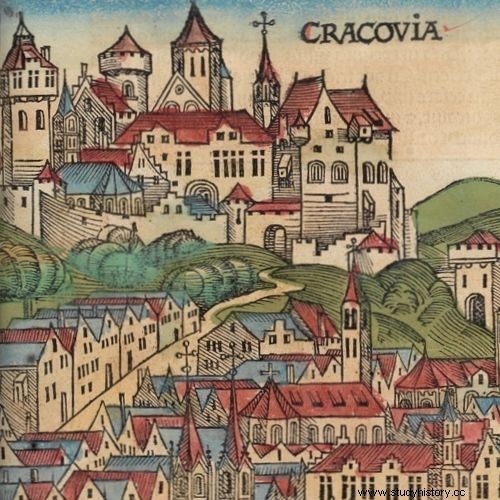
The Gothic Wawel in the oldest preserved panorama of Krakow, from 1493.
Nobody could accuse her (as it was rightly done in earlier years) that she was reluctant to act, that she lacked the eggs and the understanding of the situation. The queen resolved all disputes vigorously, made key decisions, rewarded loyal officials and loyal townspeople. She also made sure that after her departure, the power in Poland was taken over by the people closest to her. She finally left the country in November of the same, 1379, feeling that everything was under control.
"We can obtain our soul's salvation"
She can still be seen at noble conventions, at the court, where she advises Ludwik, and finally - surrounded by her daughters and nieces, whose future and upbringing she is undoubtedly very interested in. The Queen, however, thinks the most about the inevitable end.
In April 1380, he wrote a will. And he devotes as much space to distributing his property as ... emphasizing his own achievements and qualities. Already in the first sentences she writes (of course, as befits a queen, in the plural) that she is "absolutely certain that thanks to our gracious ordinance we can obtain among other Christians the salvation of our soul by the supreme Creator." She also explains what is of primary importance to her.

Elizabeth as a gracious donor and pious ruler. A miniature of the so-called The Illustrated Chronicle
"First and foremost" is to be buried not in the official royal necropolis, but in the "Corpus Christi Chapel in the Monastery of the Blessed Virgin in Old Buda" which he has built. Then he commends "to the very lord the king, our son, and the queen, his spouse, all concern for our soul, and to their leadership and management the abovementioned monastery". This passage reflects the anxiety that has accompanied Elizabeth for several decades - since the greedy ecclesiastical dignitary broke into her husband's crypt and ransacked Karol Robert's body. Elizabeth wasn't going to risk her body being disgraced as well.
A dragon's tongue for a son, a castle for a daughter-in-law
The Testament sheds light on what objects are closest to Elizabeth's heart. She gives her son Ludwik a casket for storing the relics, made "of pure gold, with eagles on one side and the emblems of the Hungarian kingdom on the other." She adds that she received this precious container once from the Queen of Naples, Sancha - that is, from the grandmother of this woman, who in 1345 organized a successful attack on Elizabeth's younger son, Andrzej. The king is also to receive another casket, containing precious chalices, relics of saints and ... "one dragon tongue made of pure gold".
Second on the list of heirs is the daughter-in-law of the old woman, the younger Queen Elizabeth of Bośniaczek. The Queen writes about her:"our daughter". And I think he really likes her sincerely, because the ruler is to receive her own favorite castle of Łokietkówna, located in Old Buda. In addition, the old woman gives her one of her handy prayer books (emphasizing immediately that it is a book "that she reads"), a golden chalice and another book "with the image of the Blessed Virgin Mary, covered with gold on the top and silver on the bottom."
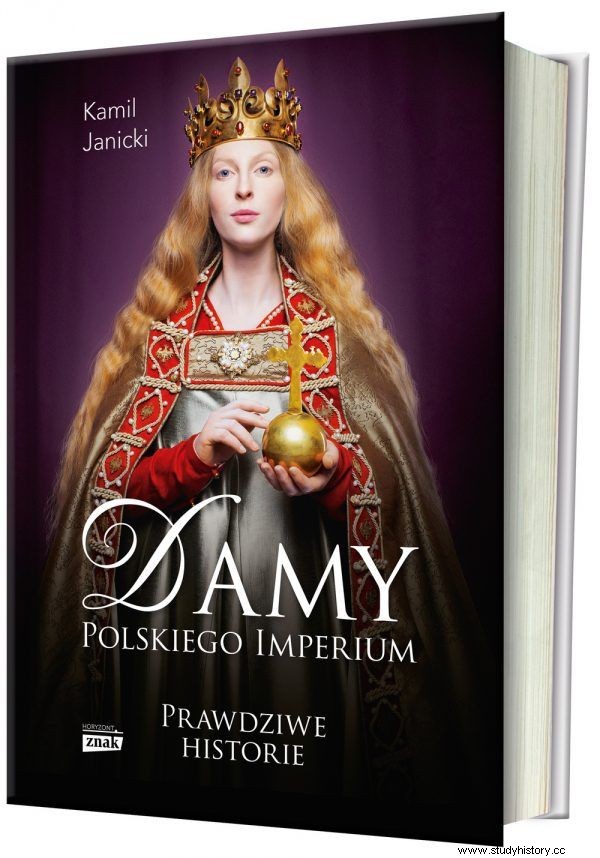
The amazing story of women who built the Polish power. Jadwiga Andegaweńska and her predecessors in a new book by Kamil Janicki:"Ladies of the Polish Empire". To buy with a discount on empik.com
Elżbieta also decides to use carefully selected ornaments for her granddaughters, known in her will as "noble virgins". Elder Mary is to receive "one diadem with two golden eagles, one necklace and one wreath worn under the headdress." In turn, "Mrs. Jadwiga" (the lady, let us recall, who was six years old in 1380) is to expect:"one diadem decorated with lilies and one necklace similarly decorated with precious pearls and stones".
Treasures for the faithful and trusted
This is just the beginning of a long list of heirs. Elizabeth, who has suffered a great deal of human ingratitude in the past, intends to generously reward all those associates who have remained faithful to her to the very end.
He saves a real fortune to his favorite mansion, a certain Klara de Pakur. The lady is to receive one village (the queen emphasizes that it is a place "bought by us"; maybe she bought it specifically for a member of the fraucimer), and a "magnificent wagon with six horses, with horseshoes", eight kilograms of silver and a breviary, which you clearly want to offer to Clara as valuable reading. He writes:"I wish her to read it until the end of her life, and after her death let it become the property of the convent of the Blessed Virgin."
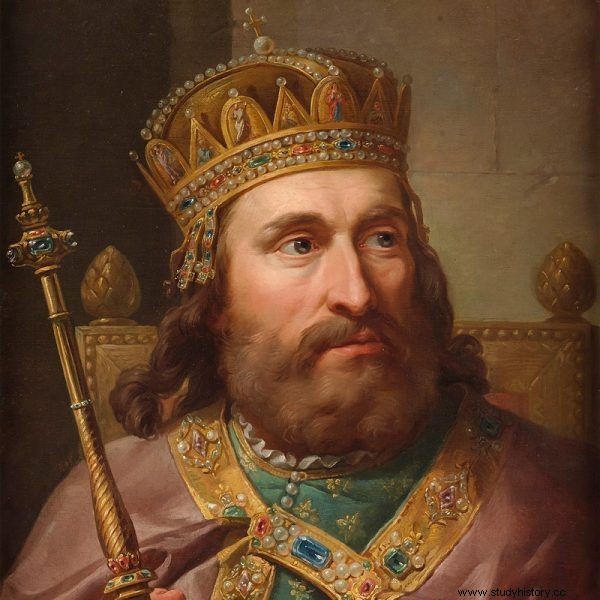
Portrait of Ludwik Węgierski by Marcello Bacciarelli.
The queen's confessor is to receive fifty gold coins. Another fifty goes to "Mrs. Margaret", presented as "a nun living in our house." For all other girls employed in the residence ("both Hungarian and Polish women"), the monarch writes down a huge sum of one thousand gold coins to be distributed, and "all the decorations of our house, namely carpets, quilts, clothes and other valuable items". Ordinary maids and maids, thanks to the will, have a chance to become crescents.
A similar reward awaits the queen's male servants. "For the young men and servants of our court, who do not have special salaries or positions," Elżbieta bequeathed a thousand gold coins, and all the horses from her studs "except for twelve, six of which will go to our funeral and we have given Mrs. Clara six."
"Money, as we know, is a lot lacking"
There are dozens of entries in total, and the monarch herself admits that… there is probably not enough gold for them. "As we know, money is lacking a lot because of our various expenses," he says in his will. And she recommends that her son, if necessary, sell off the silver vessels in her treasury, the weight of which is to reach seventeen kilograms.
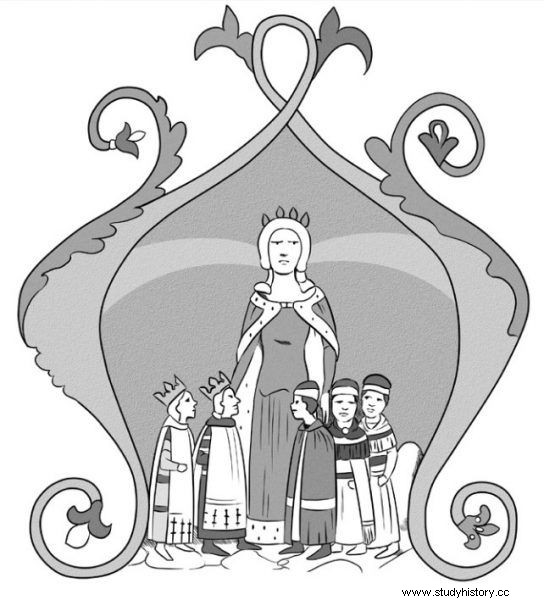
Elżbieta Łokietkówna surrounded by children. A miniature of the so-called The Illustrated Chronicle
Finally, the Queen also recommends her nominees, advisers and officials to Louis. He asks that "any governors in any of our established provinces, and especially our treasurers, do not wish to oppress or disturb them through gossip or false denunciation." She emphasizes that these people should remain beyond suspicion, because she, "thanks to the experience imparted by the Most High," knew "what should be done" when giving them titles and positions. Finally, he points out to his son not to deprive him of the dignity of "our relatives who are on duty", that is, of various Piasts who made their careers in Hungary.
The Queen does not intend to leave anything to chance, let alone give her surroundings any room for interpretation and change of her decisions. He appoints as many as seven executors of the will. Including his daughter-in-law, one cardinal, one bishop and ... faithful maid, Klara de Pakur. Experienced in the overturning of wills, she also makes every effort to ensure that the record of her last will is not changed or… lost. He orders it to be drawn up in duplicate. He leaves one outside, the other he gives to his trusted Poor Clares.
Last way
In the following months, Elżbieta continued to be interested in Polish affairs. He chooses one of his faithful people as the new bishop of Krakow. Another of her friends will be promoted to the rank of the General Starost of Wielkopolska. In the documents of Ludwik, you can see Elizabeth in the role of the most important adviser as early as November 1380. Not hiding the old grudge against the inhabitants of the city, which rebelled against its Hungarian court a few years ago, the monarch stands up for the Krakow people in their trade dispute with Nowy Sącz.
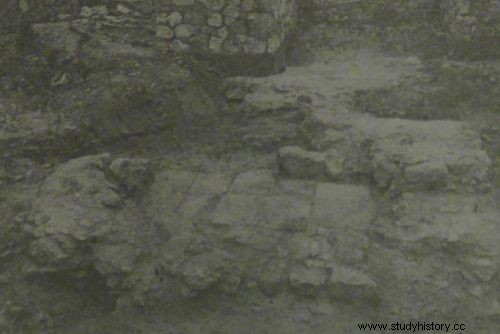
The grave of Elżbieta Łokietkówna in the photo from the scientific work entitled Discovery of the convent of Poor Clares and the tomb of Elżbieta Łokietkówna in Hungary.
He celebrates Christmas with his family. On December 29, he is at his Buda Castle, and it is here, at the age of seventy-five, that he breathes his last. Ludwik makes sure that none of her death provisions are violated. The queen's body is brought to the convent of Poor Clares and buried in a chapel which Elizabeth had prepared for herself. Her death echoes widely throughout Europe. And her figure is permanently imprinted in the consciousness of posterity.
In 1513, one of the successive popes, Leo X, announces that everyone who visits the Łokietkówna tomb chapel will receive a special indulgence. Although the monarch never officially canonization, Elizabeth still appears in the mails of saints from the seventeenth century. And only her body disappears under mysterious circumstances. The queen's beloved monastery is demolished and torn down during the Turkish invasion of 1541. The nuns escape from the convent in advance, carrying the bones of the founder with them. Where? It is not known.
The location of the monastery is blurred in the memory of Hungarians, and its ruins, buried in the ground, cannot be found until the 1970s. Archaeologists also find the remains of the chapel and a magnificent tomb covered with stone slabs. A tomb worthy of a queen. And completely empty.
Holy queens who fell in love with the authorities. The fascinating story of Jadwiga Andegaweńska and her predecessors:
Selected bibliography:
The article was based on materials collected by the author during the work on the book "Ladies of the Polish Empire. The Women Who Built a Power " . Some of these items are shown below. Full bibliography in the book.
- Dąbrowski J., Elżbieta Łokietkówna 1305-1380 , Universitas, Krakow 2007.
- Dąbrowski J., The last years of Ludwik the Great 1370-1382 , Universitas, Krakow 2009.
- Sroka S.A., Elżbieta Łokietkówna , Homini, Bydgoszcz 1999.
- Sroka S.A., Elżbieta [in:] The Piasts. Biographical Lexicon , edited by K. Ożóg, S. Szczur, Wydawnictwo Literackie, Krakow 1999.
- Śnieżyńska-Stolot E., Discovery of the convent of Poor Clares and the tomb of Queen Elizabeth in Hungary , "Biuletyn Historii Sztuki", vol. 41 (1979).
- Śnieżyńska-Stolot E., Studies on the culture of the Hungarian court of Queen Elżbieta Łokietkówna , "Historical Studies", vol. 20 (1977).
